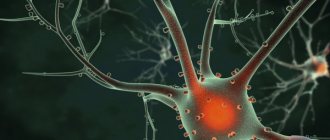Symptoms of intercostal neuralgia
The main symptom of the disease is excruciating pain in the chest, spreading along the nerve. Unpleasant sensations last for hours or even days, not leaving the person day or night. The pain can be acute, shooting or burning, the intensity is high or medium. It gets worse with coughing, sneezing and movement.
Sometimes the pain may resemble damage to the heart, stomach or spine. However, unlike intercostal neuralgia, cardiac pain goes away after taking nitroglycerin, and gastric pain goes away after antispasmodics.
Other signs of the disease:
- muscle tension;
- numbness of the affected area;
- tingling, sensation of goosebumps;
- sensitivity disorder;
- sleep disturbance;
- tearfulness;
- increased sweating.
The temperature with intercostal neuralgia may also rise. The skin in the outbreak turns red or white. If the cause of the disease is herpes zoster, characteristic rashes appear along the nerve.
Causes and symptoms of the disease
Doctors call advanced osteochondrosis . Sometimes the disease can be triggered by diseases such as kyphosis, spondylitis, ankylosing spondylitis. In addition, an attack occurs due to a cold, hypothermia, previous infections and injuries, poisoning, stress, and unusual physical activity.
The most obvious symptom of the disease is chest pain. A person experiences attacks that worsen when coughing or taking a deep breath. When pressing, you can detect several pain points. The pain is concentrated between the ribs, often accompanied by burning, numbness, and stabbing sensations, but can also be felt in other areas.
The symptoms are similar to those of a heart attack , but there are some differences. With neuralgia, the pain does not change in intensity, but is felt constantly, the pulse and pressure are normal. In any case, if such pain occurs, it is better to consult a doctor.
In addition to pain , intercostal neuralgia causes the following symptoms: muscle contraction, redness or unnatural paleness of the skin, severe sweating, partial numbness of the skin.
Treatment of intercostal neuralgia
In case of severe pain, a person needs bed rest. It is necessary to limit mobility as much as possible to reduce pain.
The disease is treated by a neurologist. The specialist prescribes drugs from the following groups:
- painkillers (analgin) in injections and tablets;
- novocaine and lidocaine blockades. Injections of these drugs along the nerves are also effective in relieving pain;
- anti-inflammatory drugs (Voltaren);
- muscle relaxants. Relieves pain caused by muscle spasm;
- B vitamins. Normal functioning of nervous tissue is restored.
In the subacute stage, doctors recommend the following methods for treatment:
- UHF;
- electrophoresis with novocaine;
- laser therapy;
- magnetic therapy;
- acupuncture.
In complex therapy, the doctor also prescribes creams and ointments: painkillers, anti-inflammatory, warming.
Symptoms and diagnosis of intercostal neuralgia
The disease can be suspected first of all if:
- Acute pain.
- Burning sensation.
- Tingling.
- Back muscle tension.
The pain can be paroxysmal, excruciating, resemble pain in the heart, and radiate to the shoulder blade or epigastric region. It gets worse when coughing, sneezing or turning the body. A person is forced to take this body position in order to alleviate his condition. The duration of the condition is 4-7 days.
Some areas of the skin in the chest area may lose sensitivity or, on the contrary, be painful when touched.
Additional symptoms of intercostal neuralgia:
- Heavy sweating.
- Sharp fluctuations in blood pressure.
- Pain in the lumbar spine.
The main thing in diagnosing intercostal neuralgia is to differentiate its symptoms from life-threatening heart pain. Main differences:
- Heart pain is relieved with Nitroglycerin tablets.
- The pain in the heart radiates to the left shoulder or arm, and the person feels an arrhythmia.
- In case of heart disease, the pain is short-term, the sensation does not change with a deep breath.
Pain due to neuralgia intensifies when palpating the intercostal spaces, while bending or turning the body. Nitroglycerin does not help, but warmth and painkillers bring relief.
In some cases, it is important to exclude pneumonia, pleurisy and stomach ulcers.
The doctor makes a diagnosis based on the patient’s complaints and careful palpation of the ribs with spaces between them. In difficult cases, examination is indicated, for example:
- Computed tomography or MRI of the entire spinal column.
- X-ray of the spine and chest organs.
- Ultrasound of the heart and electrocardiogram for complaints of pain on the left (to rule out heart disease).
- Electroneurography for suspected nerve injury.
- Gastroscopy to exclude gastrointestinal pathologies.
Additionally, a general blood and urine test is prescribed to have an idea of the patient’s health status, the presence/absence of an infectious process, and kidney function.
Types of neuralgia
Neuralgia is divided into:
- Neuralgia of the spinal (intercostal) nerves
- Neuralgia of the cranial (glossopharyngeal, trigeminal) nerves
- Neuralgia of the femoral nerves
In our clinic we treat all types of neuralgia, using the most modern means and methods.
Trigeminal neuralgia
Most often, this disease manifests itself in people after 40 years of age, women suffer more often. The symptom is acute pain that is difficult to tolerate. It appears in one half of the face (less often in two) and can last several minutes or appear in the form of separate “shooting” attacks. It may appear during chewing, brushing teeth, or during irritation of certain special points on the face. At the moment of pain, numbness of the facial skin and twitching of the muscles on the affected side are felt.
The cause is often compression of the nerve by surrounding tissues.
Causes of trigeminal neuralgia:
- Hypothermia of the face
- Aneurysm of one of the arteries of the skull
- Abnormal arrangement of cerebral vessels
- Removal of a tooth
- Chronic infections in the facial area (sinusitis, caries)
- Brain tumors
Intercostal neuralgia
The cause of acute chest pain is intercostal neuralgia. Its symptoms resemble an attack of myocardial infarction and often “scare” patients. The pain is often girdling in nature and can occur unexpectedly, but more often when changing body position, coughing, or taking a deep breath. There is numbness or “crawling” in the affected area.
The causes of intercostal neuralgia are:
- Chest injuries
- Hypothermia of the back or chest area
- Uncomfortable body position (which persists for a long time) or a sharp turn of the body
- Various diseases of the thoracic spine
If all the symptoms are present, and blisters with clear liquid appear on the skin, then the cause is shingles.
Occipital neuralgia
Occipital neuralgia manifests itself as acute pain in the neck and/or back of the head on one or both sides. It can occur suddenly, during some sudden movement. The pain may be felt behind the ears and even radiate into the eyes.
The main causes of the development of occipital neuralgia are:
- Osteochondrosis
- Tumors in the cervical vertebrae
- Hypothermia in the back of the head or neck
- Cervical spine injuries
It can occur during a sharp turn of the head against the background of absolute health.
Neuralgia of the external cutaneous nerve of the thigh
If you feel shooting pain along the outer surface of the thigh, then this is a manifestation of neuralgia of the external cutaneous nerve of the thigh. When moving, the attack intensifies, numbness and burning appear.
Neuralgia of the pterygopalatine ganglion
An attack of the pterygopalatine ganglion is difficult. It begins unexpectedly (often at night) and can last for several hours. It manifests itself as a burning pain that is difficult to endure in the area of the eyes, temples, neck, and soft palate. The pain is bursting in nature.
Neuralgia of the glossopharyngeal nerve
Neuralgia of the glossopharyngeal nerve is not common. It manifests itself as pain in the throat, which spreads to the lower jaw and ear.
Read also
Clubfoot
Clubfoot should not be understood as just one foot disorder.
This is a group of deformities of the foot and ankle joint with their pathological setting. Clubfoot is a deformity in which… Read more
Atherosclerosis
Atherosclerosis is a vascular disease that is caused by a decrease in the elasticity of the vascular wall, the deposition of cholesterol on the inner surface and, as a result, the appearance of atherosclerotic plaques. Atherosclerosis…
More details
Pelvic pain
Pelvic pain is pain in the muscles that form the pelvic floor and organs located in the small pelvis, caused by microtrauma, chronic deformation of the sacrococcygeal region due to anatomical…
More details
Myositis
Myositis is a group of diseases characterized by an inflammatory process in skeletal muscles. Depending on the cause of the disease, there are several forms of myositis: Autoimmune…
More details
Multiple sclerosis
Multiple sclerosis (MS) is a chronic disease, contrary to popular belief, completely unrelated to attention disorders and senile sclerosis. In this case, the term “sclerosis” means...
More details
Causes of intercostal neuralgia on the right side
The disease itself is not considered a serious pathology, but its insidiousness is that it begins to manifest itself against the background of other, truly complex health disorders, which can even lead to death.
The following reasons lead to intercostal neuralgia on the right:
- hernias between the vertebrae or their displacement;
- injuries to the ribs, muscle tissue;
- intoxication;
- advanced viral conditions;
- hypertrophy of the spinal muscles.
Additionally, the risk of developing neuralgia on the right side increases:
- lack of rest;
- avitaminosis;
- harmful addictions;
- endocrine disruptions;
- metabolic disorders;
- excessive physical activity;
- obesity.
Intercostal neuralgia on the right side in women gives symptoms when wearing tight underwear or corsets. Also in women, the rib skeleton may have a small layer of fat, which increases the risk of injury.
Symptoms and manifestations
The signs of intercostal neuralgia on the right are quite specific:
- loss of sensation of the sternum on the right;
- paroxysmal pain localized in the cardiac region;
- discomfort in the arm, transmitted through it to the shoulder, shoulder blade and lower back;
- heart rhythm disorder;
- the need to strain the sternum (coughing, turning, etc.) increases the pain;
- curvature of the spine to achieve a comfortable position;
- sleep problems, inattention, decreased concentration as a result of oxygen deprivation (breathing problems).
Sometimes the symptoms of neuralgia are complemented by other signs:
- pale skin in the pinched area;
- muscle spasm around the affected area;
- sweating more than usual;
- fever (rare).
Due to the identity of the symptoms with manifestations of heart disease, only a doctor can diagnose and prescribe treatment.
Intercostal neuralgia
Intercostal neuralgia is a reflex pain syndrome that occurs when the intercostal nerves are compressed or irritated. Occurs more often in adults.
The most common causes of intercostal neuralgia are:
- hypothermia
- osteochondrosis, spinal hernia
- chest injuries
- herpes zoster (herpes zoster)
- less commonly, the causes of neuralgia are neoplasms of the chest cavity, pneumonia, and pleurisy.
Very often, the left-sided nature of pain in intercostal neuralgia imitates heart pathology (angina). With angina, the pain syndrome is relieved by taking nitroglycerin, and is provoked by physical activity.
When intercostal neuralgia is localized in the lower parts of the spine, pain can imitate diseases of the stomach (gastric ulcer) and pancreas (acute pancreatitis). In this case, the pain is bilateral in nature and is associated with food intake.
Clinical manifestations of neuralgia are pain along the intercostal space, often unilateral, of a “piercing” nature, intensified by deep breathing, coughing, sneezing, and turning the body.
The patient may be disturbed by pathological disturbances of sensitivity in the area of pain in the form of itching, “crawling”, burning, etc.
With herpes zoster (herpetic radiculoneuritis), rashes in the form of “bubbles” appear in the area of pain along the intercostal spaces.
When diagnosing intercostal neuralgia, it is important to distinguish it from other serious diseases that it can mimic. Therefore, a patient with acute chest pain must exclude diseases of the heart, lungs, and gastrointestinal tract (an ECG, FLG of the chest organs, and, if necessary, ultrasound of the abdominal organs, fibrogastroscopy are required).
On examination, a forced position of the patient with an inclination to the affected side, pain on palpation of the intercostal spaces on the side of the pain, and an area of decreased sensitivity in the corresponding area of the skin are noted.
When the diagnosis of intercostal neuralgia is confirmed, adequate treatment of the disease is necessary:
- Prescribing anti-inflammatory drugs intramuscularly or in the form of therapeutic intercostal blocks for severe pain, in tablet forms for moderate pain. For herpes zoster, etiotropic antiviral drugs must be prescribed.
- Mode with limited physical activity, wearing a corset on the spine for up to 4 hours a day
- Physiotherapy (magnetic therapy, ultrasound)
- Gentle manual therapy, “relaxing” massage
- Apply ointments with a moderate warming effect locally to the intercostal area.
In order to prevent the occurrence of intercostal neuralgia, several rules must be followed:
- avoid hypothermia, long stays in one position;
- avoid spinal injuries;
- maintain an optimal motor mode, monitor your posture (visiting the pool or gym up to 3 times a week or walking up to 4 km daily).
Be attentive to yourself and your health!
Diagnosis and treatment of neuralgia
To make a diagnosis of neuralgia, you need to consult a neurologist. Diagnosis is carried out on the basis of the characteristic symptoms of the disease and additional examination methods, which include nuclear magnetic resonance, computed tomography and other methods.
Treatment methods for neuralgia are selected depending on the causes that led to the development of the disease and the affected nerve.
To relieve the pain of neuralgia, medications that belong to the group of non-steroidal anti-inflammatory drugs, antidepressants, antiepileptic drugs and drugs that have a local analgesic effect are used.
Physiotherapy, acupuncture, therapeutic exercises and massage are used as general treatment methods, which have a good therapeutic effect.
For the treatment of neuralgia, carboxytherapy and mesotherapy methods with painkillers and drugs that improve blood circulation are also very effective. The basic treatment method for trigeminal neuralgia is transcutaneous electrical nerve stimulation (Cefaly).
If these methods are ineffective, then surgery is recommended, the purpose of which is to remove the tissue that puts pressure on the nerve. The canal through which the nerve passes may widen. All this leads to the disappearance of pain and complete relief from neuralgia.
Our clinic employs highly qualified specialists who effectively combine medicinal methods with physiotherapy, which helps to achieve good results in the treatment of neuralgia and significantly improve the patient’s quality of life.










